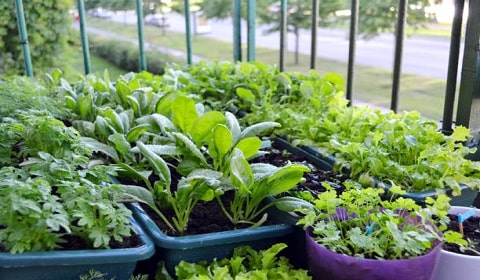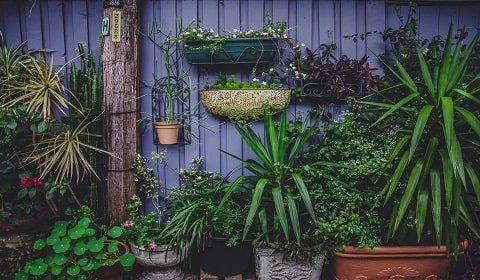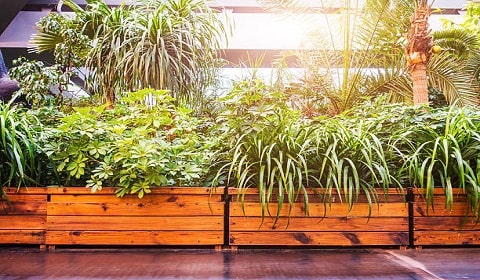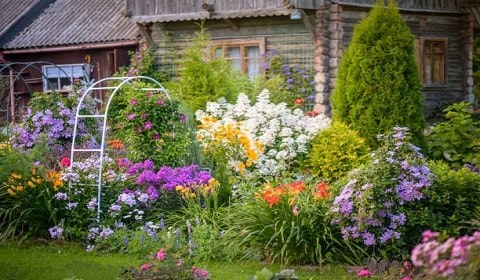Vegetable garden ideas encapsulate the essence of gratifying gardening experiences. Harvesting crops from your own plot, like plucking a ripe tomato or unearthing a vibrant carrot, fosters a unique satisfaction. It’s the culmination of nurturing your plants through the seasons, yielding literal fruits of your labor.
Everyone, regardless of space or expertise, can embrace a vegetable garden. Whether you possess an expansive yard or a modest balcony, whether you’re a seasoned gardener or a novice, these ideas pave the path to realizing your ‘grow your own’ dreams. Dive into the world of vegetable gardening; it’s a journey filled with fulfillment and the joy of cultivating your own sustenance.
Best Vegetable Garden Ideas
With the resurgence of interest in ‘grow your own,’ everyone’s on the hunt for vegetable garden inspiration and the simplest veggies to cultivate.
Whether it’s a charming herb planter nestled by the back entrance, tidy rows reminiscent of allotment plots bursting with greens, or creative vegetable garden ideas that add flair to your space, there’s a garden idea for every homeowner and plot size. Engaging kids in gardening adds another layer of joy to the process.
Factors like space and sunlight influence which ideas suit your garden best, but don’t stress over rules—just pick what fits your veggies and area. Starting a veggie patch might feel daunting, but fear not! These ideas make it a breeze to begin your own flourishing garden adventure.
Table of Contents
1. Fitting A Raised Bed Garden In A Small Backyard
Raised garden beds offer several advantages, including improved drainage, customizable soil quality, and easy maintenance, making them ideal for gardening enthusiasts.
Traditional vegetable plots, typically sized at 4×4 or 4×8 feet, can be challenging to accommodate in smaller yards. However, this shouldn’t deter you, as raised beds can be tailored to fit any space, whether narrow, long, or short.
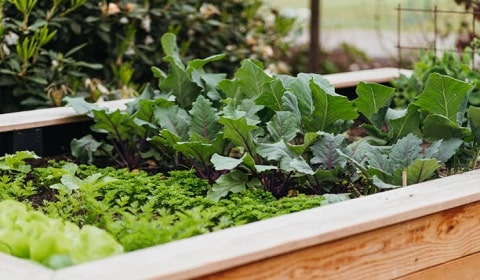
Vegetable garden ideas thrive in beds as narrow as 1, 2, or 3 feet wide. These beds can be placed along fences, walls, patios, or decks, utilizing spare space effectively. Opting for taller raised beds simplifies gardening tasks and helps deter pets and pests, requiring less space for walkways.
Utilize trellises for climbing plants like beans and cucumbers, and cages for supporting taller crops such as tomatoes and eggplants, maximizing your garden’s productivity.
Read More: Rose Garden Ideas
2. Use Pathways To Structure A Large Backyard
Having ample space for a vegetable garden doesn’t necessarily make planning easier. Large gardens often appear disorderly. However, strategically planning pathways can tidy up even the most chaotic veggie patches.
Incorporate pathways as a crucial element in your garden design, including straight or curved paths, maintaining uniform width throughout. Add vegetable garden ideas by considering how to use gravel, pebbles, or pavers to surface the walkways.
If budget is a concern, consider wood chips or ground cover like scotch moss. Ensure clear distinction and contrast between pathways and plant beds. For in-ground vegetable beds, employ edging materials like stones, wood, or flowers to delineate the planting areas from the pathways.
Read More: Tips For Growing Healthy Roses
3. Grow Climbing Vegetables On Arbors
Arbors work their magical charm by transforming vine vegetables into exquisite ornamental plants. Beans, cucumbers, zucchini, sweet potatoes, pumpkins, and squash flourish on these intricate wooden structures, showcasing their uniquely shaped and colored leaves.
To support hefty fruits like pumpkins, mesh wires are essential to prevent stem breakage. Strategically place arbors at garden entrances, along walkways, or by fences or walls, ideally with a bench nearby to enjoy the shade.
Whether directly in the soil or in sizable pots adjacent to the arbor, plant climbing veggies for maximum effect. For additional inspiration, consider integrating vegetable garden ideas into your arbor setup.
Professional arbor installation ranges from $1,430 to $4,075, but you can opt for a DIY approach or purchase one online for self-installation.
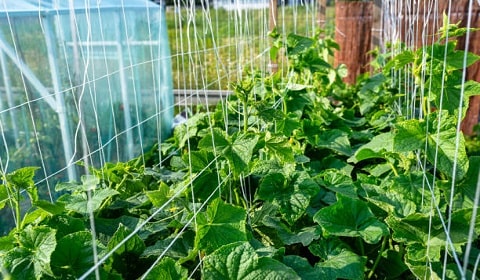
4. Herb Garden In A Window Box
Imagine the joy of plucking fresh basil or oregano straight from your kitchen window for salads and sauces. Window boxes offer this culinary delight, serving as mini gardens just outside your window.
These elongated pots are perfect for cultivating herbs due to their compact size. In a window box garden, herbs like oregano, sage, cilantro, basil, thyme, and rosemary thrive, lending not only their flavors but also delightful fragrances and delicate blooms that evoke a sunny Mediterranean feel.
They provide a steady supply of fresh herbs for cooking and can be dried for later use. For avid homemade pesto enthusiasts, adding extra basil ensures an ample supply for this delectable sauce. Additionally, incorporating vegetable garden ideas into your window box arrangement can expand your culinary repertoire even further.
Read More: Tips For Growing Roses in Pots
5. Make Your Garden Look Pop-Up With Layers
Potager gardens exemplify the art of blending aesthetics with practicality in vegetable cultivation. One key technique is the strategic arrangement of plants in varying heights to enhance visual appeal and functionality.
To replicate this in your own garden, consider positioning taller crops at the center of beds, especially if the beds are accessible from all sides. Utilize pyramid trellises or arbors to support climbing plants like beans, cucumbers, and zucchini. Alternatively, opt for sturdy cages to bolster tomatoes, eggplants, and peppers.
Reserve the outer edges for smaller varieties such as beets, spinach, lettuce, arugula, and carrots, while interspersing kale, cabbage, broccoli, and peas in between for an efficient use of space and a diverse yield. For further inspiration and to explore creative layout options, browse through various vegetable garden ideas.
6. Mix Edible Flowers In Your Salad Garden
Successfully managing an edible garden hinges on planting what tantalizes your taste buds and complements your culinary adventures, including vegetable garden ideas. If salads are your go-to, opt for lettuce, spinach, arugula, radishes, carrots, tomatoes, cucumbers, and onions.
Elevate your salad game by incorporating aromatic herbs such as basil, oregano, cilantro, and don’t forget to add edible flowers for a visually stunning garden.
Consider varieties like nasturtium, viola, pansy, and dianthus to border your garden beds; they won’t overshadow your veggies while adding a delightful pop of color and flavor to your salads.
7. Expand A Salsa Garden With Containers And Alternative Gardening
In the realm of garden design, maximizing space with alternative planting methods is a prized concept, akin to finding a golden goose. Utilizing containers, hanging baskets, wall planters, and suspended gutter gardens offers an array of creative possibilities, including vegetable garden ideas.
To embark on a multi-tiered vegetable garden journey, begin by crafting a list of essential veggies and herbs. Place larger plants with deep roots, like tomatoes and tomatillos, in garden beds. In a salsa-themed garden, envision a vibrant mix of tomatoes, tomatillos, peppers, cilantro, onion, and garlic. Tomatoes and tomatillos find their home in either in-ground or raised beds.
Peppers can join if space allows, or they thrive in sizable containers. Cilantro can grace a hanging basket, while onions and garlic may flourish in wall planters or suspended PVC gutter beds.
8. Grow Leafy Greens In A Gutter Garden
Spinach, lettuce, arugula, and Swiss chard offer a bounty of fiber and vital minerals vital for a well-rounded diet. Beyond their nutritional prowess, they lend an aesthetic charm when nestled in makeshift pots crafted from PVC gutters affixed to fences or mounted on walls.
These leafy greens thrive in cooler climates, thriving with just 4 to 5 hours of direct sunlight. Their adaptability makes them ideal candidates for urban gardening or spaces with limited sunlight exposure.
For those seeking more variety, exploring vegetable garden ideas can further enrich the possibilities of urban green spaces.
9. Hide The Veggies And Herbs In Your Front Yard Flower Garden
Creating an attractive vegetable garden hinges on its organized layout, with orderly rows and strategic groupings. Transforming your front yard into a veggie haven offers an opportunity for creativity.
Introduce flair by intermingling vegetables amidst flowering plants, whether edible or ornamental, for a visually captivating effect. Adhering to two fundamental guidelines ensures optimal growth: consulting a companion planting chart to avoid incompatible pairings and positioning taller plants towards the rear or northern side, while shorter varieties occupy the front or southern region to ensure adequate sunlight exposure for all plants.
Incorporating innovative vegetable garden ideas into this blend of aesthetic appeal and practicality enhances both the visual allure and functionality of your vegetable garden.
10. Mulch Your Way Into A Time And Water-Saving Garden Design
Mulch, crafted from wood chips, straw, hay, or even grass clippings, is like the canvas for your garden masterpiece. Beyond its aesthetic charm, it’s a game-changer in landscape design. A small garden suddenly appears more spacious, bustling areas acquire an air of sophistication, and the foliage appears lusher while blooms and fruits explode with vibrant hues.
But there’s more to it than just looks. Mulch acts as a shield for the soil, warding off excessive heat and evaporation, thereby reducing the need for frequent watering, especially for vegetable patches. Additionally, it’s a natural weed deterrent, minimizing the hassle of constant weeding and the necessity for herbicides, making your gardening experience both visually pleasing and environmentally friendly.
For those seeking to elevate their gardening endeavors further, incorporating innovative vegetable garden ideas alongside mulch application can unlock a realm of creativity and productivity.
11. Install A Vertical Garden On Your Balcony
Passionate about cultivating veggies but limited to a small balcony? No sweat! Opt for a vertical balcony garden. Start with 2 or 3 cherry tomatoes and peppers in floor containers, adding a bean plant each, guiding them upward with trellises or rope.
Incorporate 1 or 2 cucumber plants in pots, training them to climb a sunny wall using trellises. Utilize a wall planter for leafy greens, radishes, onions, garlic, and chives. Don’t overlook aromatic herbs! Install a railing planter for them, perfect for small edible flowers.
For additional inspiration, consider incorporating vegetable garden ideas into your space. With this setup, your compact space transforms into a lush, productive oasis.
12. Bush And Dwarf Plants For Beginners
For novice gardeners seeking vegetable garden ideas, opting for bush and dwarf plant varieties, whether in pots or directly in the soil, proves to be advantageous. These selections maintain a tidy appearance, remain compact and healthy, and demand less water and pruning.
Notably, dwarf tomato, pepper, and eggplant varieties yield bountiful crops while boasting manageable sizes, seamlessly fitting into any garden layout with a simple rule of thumb: one plant per square foot suffices.
This approach not only simplifies gardening tasks but also ensures a productive and visually appealing garden for beginners to enjoy.
13. Garden Design With Edible Ground Covers
Why limit your garden to just veggies, herbs, and edible flowers? Consider incorporating edible ground covers for an enchanting forest-like vibe and vegetable garden ideas. These low-maintenance plants not only enhance aesthetics but also nurture soil health, retaining moisture and fostering beneficial microbes.
They even provide extra edibles for your kitchen. Sweet potatoes, for instance, offer both tasty leaves and tubers come autumn. Nasturtium is another tasty choice; its edible leaves, stems, and vibrant flowers not only adorn salads but also beckon essential pollinators.
Embrace these edible ground covers to elevate your garden’s allure while reaping additional culinary delights.
14. Vegetable Garden Design Ideas With A Low Budget
Starting a vegetable garden needn’t break the bank. Many items you might consider purchasing can be substituted with free or low-cost alternatives. Let’s start with the essentials: seeds and transplants.
Instead of buying seedlings from the store, opt for starting your plants from seeds, saving seeds from your harvest for future use. For germination trays, think outside the box – yogurt containers, egg cartons, and even styrofoam meat trays work just as well.
Swap out pricey pots for buckets or sturdy plastic bags, ideal for growing peppers and cucumbers. Build your garden beds inexpensively using pallet wood. If you’re looking for more vegetable garden ideas, consider repurposing old tires or wooden crates. Rather than splurging on fertilizers and soil, create your compost heap and source manure locally for free.
Utilize dry leaves and grass clippings as mulch. Repurpose a barrel for rainwater collection, cutting down on water bills while providing your plants with pure, chloramine-free water.
15. Make It A Pergola Garden
Pergolas provide a wonderful opportunity to cultivate climbing vegetables such as cucumbers, zucchini, beans, squash, and pumpkins. If you already have a pergola in your backyard, you’re halfway there; there’s no need for additional expenses.
Simply adorn it with lush greenery and integrate some creative vegetable garden ideas. However, if you don’t have one, you can have a pergola installed professionally for around $4,000. Alternatively, you can opt for a more budget-friendly approach by building your own or using a kit.
Plant your vegetables in containers strategically placed around the pergola to avoid obstructing foot traffic. Guide the vines upwards using ropes or install climbing nets and trellises. Bask in the shade while admiring the flourishing crops.
16. Use Tall Raised Beds Instead Of The Furrow Method For Root Vegetables
Root vegetables such as carrots, beets, turnips, and parsnips thrive when planted in mounds formed by digging rows on your property. However, these mounds often lack aesthetic appeal. For a more visually pleasing garden, consider replacing the traditional furrow method with raised beds.
These beds should be at least 8 inches tall and filled with loose, nutrient-rich soil. Keep in mind that the true treasures of root vegetables lie beneath the soil, so don’t be discouraged by their modest appearance above ground.
To enhance the bed’s appearance, intersperse with vibrant plants like marigolds, lettuce, or fragrant herbs. This not only adds visual interest but also complements the growth of root vegetables. Another option to consider is incorporating various vegetable garden ideas into your raised beds to maximize space and yield.
17. Theme Garden With Italian Or Thai Veggies
Creating a theme garden featuring Italian or Thai veggies or exploring vegetable garden ideas adds cultural flair to your outdoor space while offering a range of benefits. Italian vegetables like tomatoes, basil, and zucchini thrive in warm climates, providing fresh ingredients for classic dishes such as Caprese salad and pasta sauces.
Thai vegetables such as lemongrass, Thai basil, and Thai eggplant add unique flavors to curries and stir-fries. However, some challenges include specific climate and soil requirements for these plants. Nevertheless, the cost benefits are significant, with homegrown produce reducing grocery expenses and promoting sustainable living.
According to the USDA, home gardens save an average of $530 annually. So, unleash your culinary creativity while reaping the rewards of a themed vegetable garden.
18. Recycle Old Tires Or Pallets For Raised Beds
Repurposing old tires or pallets for raised beds is a sustainable approach to vegetable gardening. According to EPA, each year, over 290 million tires are discarded in the U.S., posing environmental hazards. By converting them into raised beds, we mitigate this waste. T
hese beds offer excellent drainage and heat retention, ideal for vegetables like tomatoes, peppers, and lettuce. However, caution must be exercised due to potential leaching of chemicals from tires. Additionally, pallets may contain harmful substances.
Despite this, the cost-effectiveness of these materials is undeniable, with upcycling offering substantial savings compared to purchasing traditional raised bed materials. Embracing this method not only benefits the environment but also yields fresh produce while minimizing expenses.
For more creative vegetable garden ideas, considering incorporating recycled materials like old tires or pallets can further enhance sustainability efforts.
19. Add Trellis For Vining Crops Like Cucumbers
Incorporating trellises for vining crops like cucumbers elevates your vegetable garden’s efficiency and yield. According to a study by the University of California, trellising can boost cucumber yields by up to 40%. The primary advantage lies in maximizing space utilization, ideal for small gardens.
Cucumbers, pole beans, and peas thrive when vertically supported. However, trellising demands initial investment in materials and installation, which may deter some gardeners. Yet, the long-term benefits outweigh costs; trellises prolong plant longevity, reduce disease risk, and facilitate easier harvesting. Additionally, trellised crops encounter fewer pests.
Ultimately, the cost-benefit analysis showcases substantial savings in water usage and increased crop yield, making trellising a smart investment for any vegetable gardener looking for innovative vegetable garden ideas.
20. Sensory Garden: Colorful Peppers, Aromatic Herbs
Transform your garden into a sensory delight with vibrant peppers and aromatic herbs, incorporating innovative vegetable garden ideas. This concept not only adds visual appeal but engages all senses.
Peppers like bell, chili, and jalapeño offer a spectrum of colors, while herbs like basil, rosemary, and mint release enticing aromas. Beyond aesthetics, sensory gardens boast numerous benefits. They promote relaxation, stimulate cognitive function, and encourage mindfulness. Additionally, growing your vegetables enhances sustainability and reduces carbon footprint.
However, upkeep demands attention as diverse plants require specific care. Despite potential challenges, the long-term cost benefits outweigh initial investments. With careful planning and maintenance, a sensory garden teeming with peppers and herbs enriches both body and mind.
21. Try Square Foot Gardening For Space Efficiency
Maximize your gardening space with the ingenious technique of square foot gardening, which offers a plethora of vegetable garden ideas. This method divides your garden into square-foot sections, optimizing space and efficiency.
Studies show square foot gardening can yield up to 100% more produce compared to traditional methods. It’s ideal for small yards, balconies, or even urban spaces. You can grow a variety of vegetables like lettuce, carrots, tomatoes, and peppers. However, it requires precise planning and regular maintenance.
While initial setup costs may be higher due to raised beds and soil amendments, the long-term benefits outweigh the investment. With reduced water usage and minimal weeding, square foot gardening offers not just bountiful harvests, but also cost savings and environmental sustainability.
22. Harvest Rainwater For Sustainable Irrigation
Harvesting rainwater for sustainable irrigation in your vegetable garden is a smart eco-friendly choice. With primary rainwater collection systems like rain barrels or cisterns, you can reduce reliance on municipal water, conserving resources and cutting costs.
This method not only benefits the environment but also ensures healthier plants due to the absence of chemicals found in tap water. Vegetables like tomatoes, peppers, and cucumbers thrive with rainwater irrigation. Implementing vegetable garden ideas into your rainwater harvesting setup can further enhance its efficiency and productivity.
However, challenges like initial setup costs and space requirements for storage may arise. Despite this, the long-term cost benefits and positive impact on the environment outweigh the demerits. Embracing rainwater harvesting promotes sustainability while yielding bountiful, organic produce.
23. Install Drip Irrigation For Water Efficiency
Installing drip irrigation systems in vegetable gardens enhances water efficiency, benefiting both the environment and plant health. Primary benefits include reduced water wastage by up to 50% compared to traditional irrigation methods, making it an excellent choice for sustainable vegetable garden ideas.
This method suits a variety of vegetables like tomatoes, peppers, and cucumbers, ensuring precise water delivery to the root zone while minimizing weed growth. Demerits may include initial setup costs and occasional maintenance requirements.
However, the long-term cost benefits are significant; studies show that drip irrigation can increase crop yield by up to 30%, translating to substantial savings in water and labor. Opting for drip irrigation aligns with sustainable gardening practices, conserving resources while maximizing vegetable production.
24. Community Veggie Garden For Shared Produce
A community vegetable garden fosters communal spirit while promoting sustainability and offering endless possibilities for vegetable garden ideas. Studies show such gardens enhance social cohesion by 70% and reduce food miles by 50%, curbing carbon emissions.
Planting a variety of vegetables like tomatoes, lettuce, and peppers ensures diverse produce for participants. However, challenges like pest infestations and uneven contributions can arise, requiring vigilance.
Yet, the benefits outweigh drawbacks; for every $1 invested, $6 worth of vegetables are produced, cutting grocery bills by 30%. With over 20,000 community gardens in the US alone, it’s evident these spaces not only provide fresh, organic produce but also cultivate bonds among neighbors, enriching communities both socially and economically.
